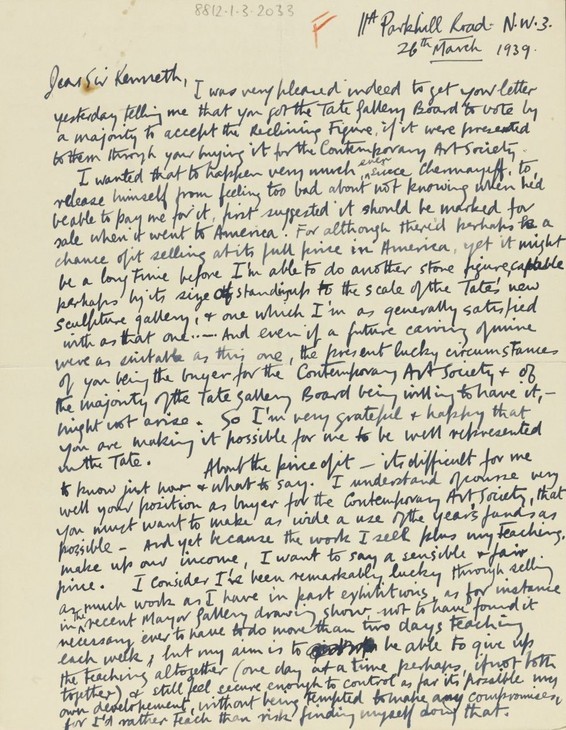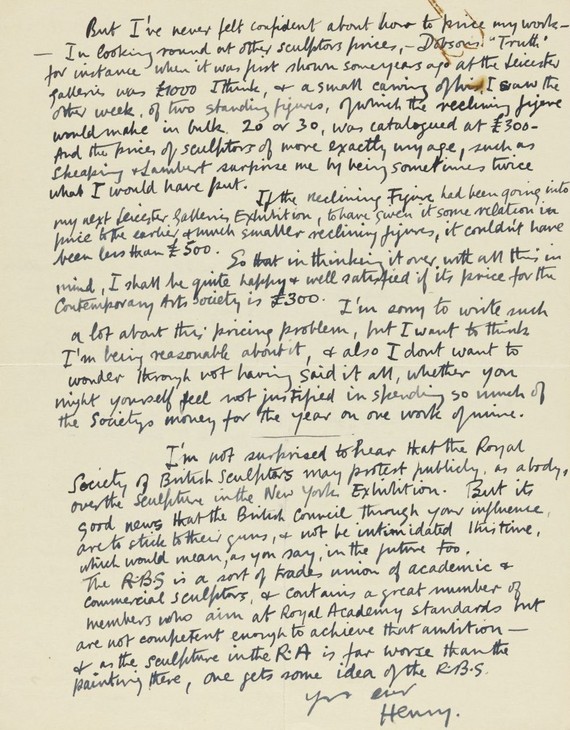Henry Moore Letter to Sir Kenneth Clark 26 March 1939
Kenneth Clark bought a drawing from Henry Moore’s first solo exhibition at the Warren Gallery, London in 1928 but the two men did not form a close friendship until the late 1930s (Clark became Director of the National Gallery in 1934). In this letter Moore expresses his gratitude to Clark for engineering the acquisition of his Recumbent Figure 1938 (Tate N05387) by the Tate Gallery. This was achieved through Clark using his position as a buyer for the Contemporary Art Society (CAS) to purchase the work and the CAS agreeing to then present it to the gallery as a gift.
Note that the plan was agreed only by a majority of the Tate Trustees, not all, and Moore recognised that he was in many ways fortunate in the combination of circumstances that made this acquisition possible. He very much wanted ‘to be well represented in the Tate’, and felt this sculpture was among the few he had produced to date, or was likely to produce in the near future, that by its size would be capable of ‘standing up to the scale of the Tate’s new sculpture gallery’ (the Duveen Sculpture Galleries were opened to the public in 1937).
The price of the work, however, had yet to be finalised, and here Moore set out his reasoning for saying that the work was worth at least £500 but that he would be content if paid only £300 by the CAS, knowing that it would be awkward for Clark if so much of its annual budget was spent on acquiring just one work by him. The letter also reveals Moore’s thoughts about the prices of work by his contemporaries, including Frank Dobson and John Skeaping.
Transcript
[Handwritten:]
11A Parkhill Road N.W.3
26th March 1939
Dear Sir Kenneth,
I was very pleased indeed to get your letter yesterday telling me that you got the Tate Gallery Board to vote by a majority to accept the Reclining Figure, if it were presented to them through your buying it for the Contemporary Art Society.
I wanted that to happen very much ever since Chermayeff, to release himself from feeling too bad about not knowing when he’d be able to pay me for it, first suggested it should be marked for sale when it went to America. For although there’d perhaps be a chance of it selling at its full price in America, yet it might be a long time before I’m able to do another stone figure, capable perhaps by its size of standing up to the scale of the Tate’s new sculpture gallery, and one which I’m as generally satisfied with as that one ... And even if a future carving of mine were as suitable as this one, the present lucky circumstances of you being the buyer for the Contemporary Art Society and of the majority of the Tate Gallery Board being willing to have it, – might not arise. So I’m very grateful and happy that you are making it possible for me to be well represented in the Tate.
About the price of it – it’s difficult for me to know just how and what to say. I understand of course very well your position as buyer for the Contemporary Art Society, that you must want to make as wide a use of the year’s funds as possible – And yet because the work I sell plus my teaching, make up our income, I want to say a sensible and fair price.
I consider I’ve been remarkably lucky through selling as much work as I have in past exhibitions, as for instance in the recent Mayor Gallery drawing show, not to have found it necessary ever to have to do more than two days’ teaching each week, but my aim is to be able to give up teaching altogether (one day at a time perhaps if not both together) and still feel secure enough to control as far it’s possible my own development, without being tempted to make any compromises, for I’d rather teach than risk finding myself doing that.[end of p.1]
But I’ve never felt confident about how to price my work – In looking round at other sculptors’ prices, – Dobson’s ‘Truth’ for instance when it was first shown some years ago at the Leicester Galleries was £1,000 I think, and a small carving of his, I saw the other week, of two standing figures, of which the reclining figure would make in bulk 20 or 30, was catalogued at £300 – and the price of sculptors of more exactly my age, such as Skeaping and Lambert surprise me by being sometimes twice what I would have put.
If the Reclining Figure had been going into my next Leicester Galleries Exhibition, to have given it some relation in price to the earlier and much smaller reclining figures, it couldn’t have been less than £500.
So that in thinking it over with all this in mind, I shall be quite happy and well satisfied if its price for the Contemporary Arts Society is £300.
I’m sorry to write such a lot about this pricing problem, but I want to think I’m being reasonable about it, and also I don’t want to wonder through not having said it all, whether you might yourself feel not justified in spending so much of the Society’s money for the year on one work of mine.
_____
I’m not surprised to hear that the Royal Society of British Sculptors may protest publicly, as a body, over the sculpture in the New York Exhibition. But it’s good news that the British Council through your influence, are to stick to their guns, and not be intimidated this time, which would mean, as you say, in the future too. The R.B.S. is a sort of trades union of academic and commercial sculptors, and contains a great number of members who aim at Royal Academy standards but are not competent enough to achieve that ambition – and as the sculpture in the R.A. is far worse than the painting there, one gets some ideas of the R.B.S.
Yours ever
Henry.
How to cite
Henry Moore, Letter to Sir Kenneth Clark, 26 March 1939, in Henry Moore: Sculptural Process and Public Identity, Tate Research Publication, 2015, https://www


